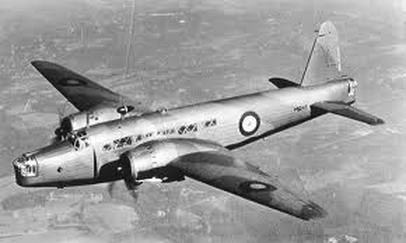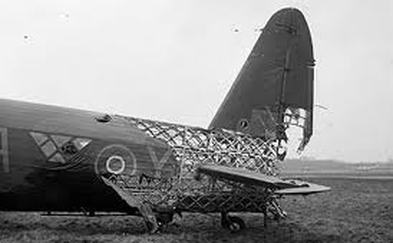The Vickers Wellington was conceived in response to a 1932 Air Ministry requirement for a heavy bomber. Vickers proposed a twin engined design with an empty weight of 6,500lbs. The (weight) limits were imposed where governments of the day were still following the Geneva Conventions, in this case a desire to actually prevent any genuinely 'heavy' bombers from being built. The Wellington utilised an airframe of geodetic construction designed by Sir Barnes Wallis. This was a completely new design and resulted in an airframe that was not only light, but also incredibly strong.
The first prototype flew in 1936, although this was a slightly different design from the first 'true' Wellington that flew in 1937. The first squadron was equipped with the Wellington late in 1938. The aircraft represented a quantum leap for RAF bomber command and triple the payload of the main bomber in use at the the time. By September 1939 there were 7 squadrons equipped with Wellingtons.
Wellingtons saw action for the first time on the first full day of WW2 on a raid against the German navy in it's home ports. This was the first of a number of daylight raids carried out by Wellingtons, but these were curtailed following heavy losses and the recognition that contrary to the thinking of the time that formations of bombers could defend themselves against fighter attacks. Actually, the failure of the raids owed as much to the German radar screen which gave early warning of the raids and ensured that resources could be vectored onto the RAF formations effectively. Although mostly unaware of the fact these raids were definitely not a surprise to the Luftwaffe.
Despite the initial setbacks the Wellington was proving to be the most capable of the medium bombers in service and its large bomb bay was able to carry 2000lb and even the new 4000lb bombs. A mark 2 version with Merlin engines (as used on the Spitfire and Hurricane and later the Lancaster bomber) was introduced in October 1940, but this was not a success and the mark 3 version was equipped with Hercules radial engines. Wally's Wellington is equipped with radial engines and based on when the picture was likely to have been taken (between Feb and Aug 1942) I would assume is either a mark 1 or mark 3. The mark 10 did not come into service until late 1942.
Peak service for the Wellington was during 1942 where in May and June it was by far the most numerous type involved in the 1000 bomber raids. The last Wellington raids over Germany took place in 1943, but the bomber remained in service with various specialist units in Bomber Command until 1945. There were still some Wellingtons in service with the RAF in 1950.
The first prototype flew in 1936, although this was a slightly different design from the first 'true' Wellington that flew in 1937. The first squadron was equipped with the Wellington late in 1938. The aircraft represented a quantum leap for RAF bomber command and triple the payload of the main bomber in use at the the time. By September 1939 there were 7 squadrons equipped with Wellingtons.
Wellingtons saw action for the first time on the first full day of WW2 on a raid against the German navy in it's home ports. This was the first of a number of daylight raids carried out by Wellingtons, but these were curtailed following heavy losses and the recognition that contrary to the thinking of the time that formations of bombers could defend themselves against fighter attacks. Actually, the failure of the raids owed as much to the German radar screen which gave early warning of the raids and ensured that resources could be vectored onto the RAF formations effectively. Although mostly unaware of the fact these raids were definitely not a surprise to the Luftwaffe.
Despite the initial setbacks the Wellington was proving to be the most capable of the medium bombers in service and its large bomb bay was able to carry 2000lb and even the new 4000lb bombs. A mark 2 version with Merlin engines (as used on the Spitfire and Hurricane and later the Lancaster bomber) was introduced in October 1940, but this was not a success and the mark 3 version was equipped with Hercules radial engines. Wally's Wellington is equipped with radial engines and based on when the picture was likely to have been taken (between Feb and Aug 1942) I would assume is either a mark 1 or mark 3. The mark 10 did not come into service until late 1942.
Peak service for the Wellington was during 1942 where in May and June it was by far the most numerous type involved in the 1000 bomber raids. The last Wellington raids over Germany took place in 1943, but the bomber remained in service with various specialist units in Bomber Command until 1945. There were still some Wellingtons in service with the RAF in 1950.


